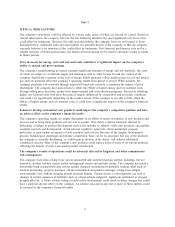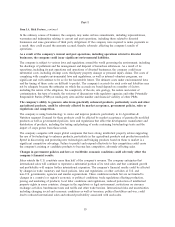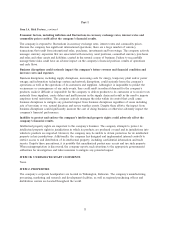DuPont 2006 Annual Report Download - page 19
Download and view the complete annual report
Please find page 19 of the 2006 DuPont annual report below. You can navigate through the pages in the report by either clicking on the pages listed below, or by using the keyword search tool below to find specific information within the annual report.
ITEM 7. MANAGEMENT’S DISCUSSION AND ANALYSIS OF FINANCIAL CONDITION AND
RESULTS OF OPERATIONS
CAUTIONARY STATEMENTS ABOUT FORWARD-LOOKING STATEMENTS
This report contains forward-looking statements which may be identified by their use of words like “plans,”
“expects,” “will,” “anticipates,” “intends,” “projects,” “estimates” or other words of similar meaning. All
statements that address expectations or projections about the future, including statements about the company’s
strategy for growth, product development, market position, expenditures and financial results are forward-
looking statements.
Forward-looking statements are based on certain assumptions and expectations of future events. The company
cannot guarantee that these assumptions and expectations are accurate or will be realized. For some of the
important factors that could cause the company’s actual results to differ materially from those projected in any
such forward-looking statements see the Risk Factors discussion set forth under Part I, Item 1A beginning on
page 9.
Overview
DuPont continues to successfully employ its three growth strategies — Putting Science to Work,Leveraging the
Power of One DuPont and Going Where the Growth Is — by leveraging resources through its five growth
platforms: Agriculture & Nutrition, Coatings & Color Technologies, Electronic & Communication
Technologies, Performance Materials and Safety & Protection. The company’s sixth reportable segment,
Pharmaceuticals, continues to receive substantial income from two anti-hypertension (AIIA) drugs, Cozaar»
and Hyzaar», developed by DuPont and licensed to Merck.
By successfully executing its three growth strategies, DuPont expects to achieve over the long term, annual
financial targets of 6 percent revenue growth, 10 percent earnings growth in earnings per share and
1 percentage point improvement in Return on Invested Capital (ROIC). In 2006, sales increased 3 percent,
diluted earnings per share increased 63 percent and ROIC increased 7 percentage points.
Putting Science to Work — Science is the basis for the capabilities, offerings and competitive advantages of
the company’s businesses. The company’s research and development programs are focused on creating new
technologies, processes and business opportunities in relevant fields, as well as improving existing products
and processes. Market-driven innovation, which relies on the voice of the customer and concrete market
opportunities, is central to the company’s research efforts. In 2006 over 1,000 new products were
commercialized, 1,800 new U.S. patent applications were filed and more than one third of 2006 sales were
derived from products introduced in the last 5 years. The company is focused on prioritizing deployment of
research resources to the most promising opportunities and is aggressively filing patent applications to protect
the intellectual property created by that research. The company has identified the top 75 technology projects
expected to generate commercial success and continues to prioritize programs for faster and larger payoffs.
Leveraging the Power of One DuPont — The company’s strategy is to increase productivity and leverage
market access, capabilities and customers, with a single focus, thereby creating wider opportunities for its
businesses. In late 2005, management committed to intensify cost and capital productivity efforts by adjusting
capital and resources allocation among its businesses. By doing so, management expects to reduce fixed costs
as a percentage of sales and increase ROIC. Target reductions of $1 billion in costs and $1 billion in working
capital savings over a three year period starting in 2006, were set to partially offset cost increases from
inflation and desired growth investments. Management exceeded its goal for fixed cost savings in 2006 by
reducing fixed costs by approximately $170 million, or approximately 2 percentage points as a percentage of
sales. In addition, the company continued to take actions to standardize and simplify its supply chains and
support functions globally and improve its sales effectiveness.
19
Part II
























